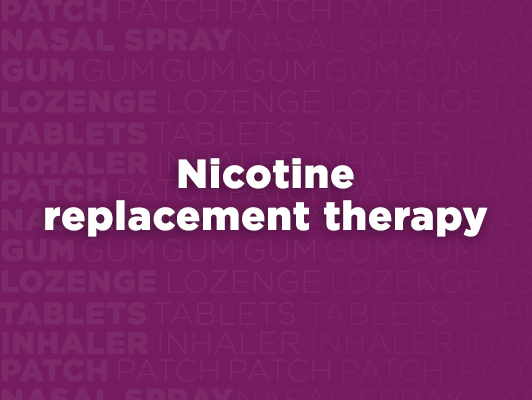Choosing a medication to quit smoking
So you’ve decided to kick the habit of using tobacco. Congratulations, that’s great!
As you move through your journey to staying tobacco-free, you may start to feel some discomfort and wonder if that’s normal.
When you first quit smoking, you are likely to experience some uncomfortable side effects commonly referred to as withdrawal symptoms. Nicotine replacement therapy (NRT) may help you with these symptoms. We recommend that anyone planning to quit using tobacco consider NRT as well as behavioral support. Research shows that using medication and behavioral support together can increase your chances of success up to six times over quitting alone.
What is NRT?
NRT is the most commonly used treatment for quitting smoking. Nicotine replacement reduces withdrawal symptoms by giving the body a dose of nicotine that satisfies cravings and the urge to smoke. As you quit smoking, you will step down to a lower dose of the medication, allowing your body to gradually get used to quitting.
What options are available?
Nicotine replacement therapy options include patches, lozenges, inhalers, gum, and a nasal spray. Some medications require a prescription. Many others are over the counter and can be purchased without a prescription. It’s always important to talk to your doctor before starting any new medication.
- Nicotine Patch: The biggest benefit of the patch is that it’s easy to use. Patches work by sticking to the skin using a bandage-like adhesive. The patch contains nicotine, which enters the body through the skin. Possible side effects include mild skin reactions, vivid dreams, and sleep disturbances. Patches are used for about eight to ten weeks but some people may require a longer treatment period.
- Nicotine Nasal Spray: Nasal spray offers the fastest delivery method. You spray the product into your nose and a small amount of nicotine is absorbed through the lining of the nose. Possible side effects include sneezing, coughing, runny nose, and watery eyes, which typically lessen after a few days. Nasal spray can be used for up to three months, but some people may require longer use.
- Nicotine Gum: Gum allows you to control the dose of nicotine you receive based on your cravings. When you use the gum, nicotine is delivered within minutes. Some people find gum is more helpful because it’s similar to the oral routine of using tobacco. The gum works by chewing and parking it inside your cheek. Small amounts of nicotine then enter the body through the lining of the mouth. Nicotine gum is typically used for 12 weeks but some people may require longer use.
- Nicotine Lozenge: Lozenges can be great for sudden cravings. The lozenges are sugar-free and will not contribute to weight gain. The lozenges release nicotine as they dissolve and the nicotine is absorbed through the lining of the mouth. Possible side effects include heart burn, indigestion, hiccups, nausea, and a sore throat. The lozenges can be used up to 12 weeks but some people may require longer use.
- Nicotine Inhaler: This small inhaler releases nicotine when puffed. The nicotine is absorbed through the lining of the mouth. Possible side effects include runny nose, sore throat, upset stomach, cough, and headache. The recommended use for an inhaler is not more than 24 months. However, some people may require longer treatment.
- Non-Nicotine Tablets — Zyban and Chantix: These medications are in a pill form and they help to reduce withdrawal symptoms and the urge to use tobacco. They have side effects ranging from nausea, constipation, gas, vivid dreams, skin rash, and seizures, to psychiatric side effects. Most people use the tablets for 12 weeks or per the recommendation of their doctor. Some people may require longer use.
How much does a nicotine replacement medication cost?
If you are a UPMC Health Plan member, generic tobacco cessation medications and nicotine replacement products are available at no cost, including nicotine patches, gum, lozenges, and bupropion (the generic form of Zyban).Brand-name products also may be available to you at no cost, but they have a step therapy requirement. That means you must try a generic product before receiving a brand-name product. Be sure to contact a Health Care Concierge at 1-888-876-2756 for more information.
Deciding to use a medication can seem overwhelming. Talk with your doctor and a health coach to discuss the options that may work best for you. These products can help you to be more comfortable and feel in control while you adjust to life without tobacco. With the right support, medication, and motivation, success is within reach!




